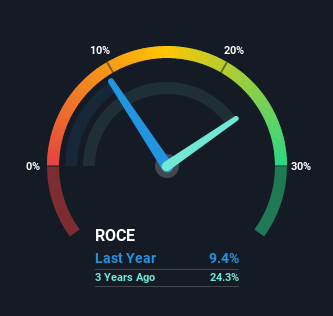- India
- /
- Construction
- /
- NSEI:SKIPPER
Skipper (NSE:SKIPPER) Will Be Hoping To Turn Its Returns On Capital Around

To find a multi-bagger stock, what are the underlying trends we should look for in a business? Amongst other things, we'll want to see two things; firstly, a growing return on capital employed (ROCE) and secondly, an expansion in the company's amount of capital employed. If you see this, it typically means it's a company with a great business model and plenty of profitable reinvestment opportunities. However, after investigating Skipper (NSE:SKIPPER), we don't think it's current trends fit the mold of a multi-bagger.
Understanding Return On Capital Employed (ROCE)
Just to clarify if you're unsure, ROCE is a metric for evaluating how much pre-tax income (in percentage terms) a company earns on the capital invested in its business. The formula for this calculation on Skipper is:
Return on Capital Employed = Earnings Before Interest and Tax (EBIT) ÷ (Total Assets - Current Liabilities)
0.094 = ₹899m ÷ (₹21b - ₹11b) (Based on the trailing twelve months to September 2021).
So, Skipper has an ROCE of 9.4%. In absolute terms, that's a low return but it's around the Construction industry average of 9.9%.
See our latest analysis for Skipper

Historical performance is a great place to start when researching a stock so above you can see the gauge for Skipper's ROCE against it's prior returns. If you want to delve into the historical earnings, revenue and cash flow of Skipper, check out these free graphs here.
What Does the ROCE Trend For Skipper Tell Us?
When we looked at the ROCE trend at Skipper, we didn't gain much confidence. Around five years ago the returns on capital were 38%, but since then they've fallen to 9.4%. However, given capital employed and revenue have both increased it appears that the business is currently pursuing growth, at the consequence of short term returns. And if the increased capital generates additional returns, the business, and thus shareholders, will benefit in the long run.
Another thing to note, Skipper has a high ratio of current liabilities to total assets of 54%. This can bring about some risks because the company is basically operating with a rather large reliance on its suppliers or other sorts of short-term creditors. Ideally we'd like to see this reduce as that would mean fewer obligations bearing risks.
In Conclusion...
While returns have fallen for Skipper in recent times, we're encouraged to see that sales are growing and that the business is reinvesting in its operations. However, despite the promising trends, the stock has fallen 51% over the last five years, so there might be an opportunity here for astute investors. So we think it'd be worthwhile to look further into this stock given the trends look encouraging.
One final note, you should learn about the 5 warning signs we've spotted with Skipper (including 2 which are concerning) .
While Skipper isn't earning the highest return, check out this free list of companies that are earning high returns on equity with solid balance sheets.
New: Manage All Your Stock Portfolios in One Place
We've created the ultimate portfolio companion for stock investors, and it's free.
• Connect an unlimited number of Portfolios and see your total in one currency
• Be alerted to new Warning Signs or Risks via email or mobile
• Track the Fair Value of your stocks
Have feedback on this article? Concerned about the content? Get in touch with us directly. Alternatively, email editorial-team (at) simplywallst.com.
This article by Simply Wall St is general in nature. We provide commentary based on historical data and analyst forecasts only using an unbiased methodology and our articles are not intended to be financial advice. It does not constitute a recommendation to buy or sell any stock, and does not take account of your objectives, or your financial situation. We aim to bring you long-term focused analysis driven by fundamental data. Note that our analysis may not factor in the latest price-sensitive company announcements or qualitative material. Simply Wall St has no position in any stocks mentioned.
About NSEI:SKIPPER
Skipper
Manufactures and sells transmission and distribution structures, telecom towers, and fasteners in India.
Reasonable growth potential with proven track record.


